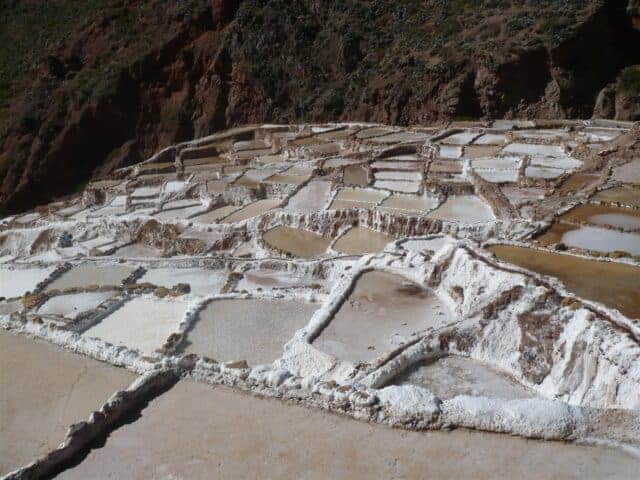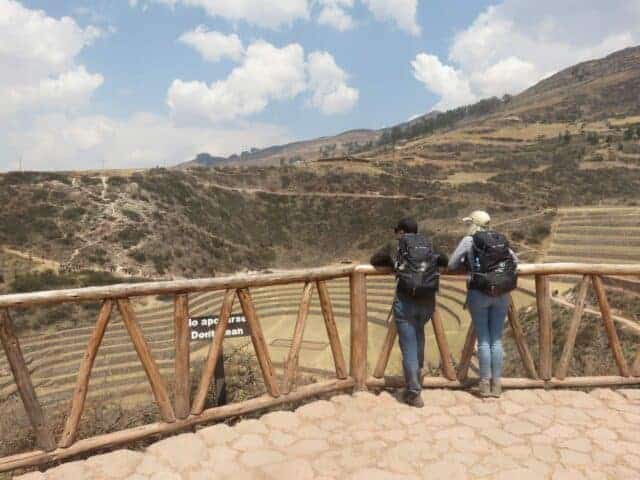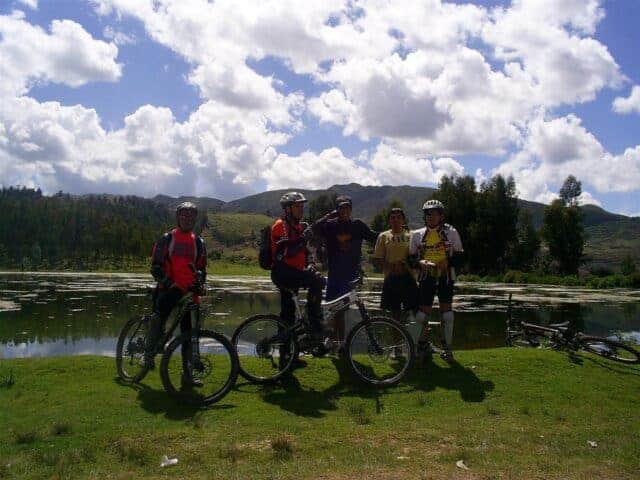Maras y Moray – Location and attractions
Two of the most important tourist centers in the city of Cusco are Maras and Moray. In these places you can appreciate part of our ancient culture in its different stages such as pre-Inca, Inca, colonial and republican. We invite you to learn a little more about these tourist attractions and also to start planning your next vacation with visits to these places. Maras and Moray are waiting for you!

Moray Cusco, Moray platforms, Sacred Valley
Moray is about 7 km southwest of Maras; an archaeological group unique in its kind in the region, which can be reached by vehicle on the dirt road without affirming or by the bridle path that leaves from the village. These are giant natural depressions or holes on the surface of the land that were used to build terraces or agricultural platforms with their respective irrigation channels in their contours. What is striking is the average annual temperature difference between the top and bottom of the depressions, that difference reaches up to 15°C in the main depression of about 30 meters deep.
In these buildings, the nature has created an environment, different conditions or microclimates that in modern times man creates in greenhouses. Moray, due to its climatic conditions and other characteristics, was an important center in the Inca Tomes for domestication, acclimatization and hybridization of wild plant species that were modified or adapted for human consumption.

Weather in Moray and the salt mines of Maras
These small villages are located on a plain surrounded by snow-capped mountains that create a dry temperate environment with plenty of rainfall, has two seasons during the year:
In the rainy season (from October to March) it is characterized by the abundant fluvial fall. The maximum temperature at this time reaches 20 ° C during the day, while at night it reaches 7 ° C.
In the dry season (from April to September), the temperature reaches 21° C during the day and 1° C at night, is in this time of year where the sky is clearer, however, rains can occur every day.
Limits of Moray and Maras Salt Mines:
- To the North: With the town of Pichingoto, the Vilcanota River, the Cristo Rey Association and the sector of Tarabamba (of Yanahuara).
- By South : With the middle course of the Salineras River.
- By East : With the skirts of the hill Retamachayoq and the plain of Llaullimoqo.
- West : With the skirts of Qaqya hill, Waqchakachi hill, Qaqawiñay hill and Cruzmoqo hill.
In the town of Maras, you will be able to appreciate the snow-capped mountains of the Sacred Valley of the Incas and Vilcabamba. The district of Maras has tourist attractions of the pre-Hispanic period, colonial and republican; in the town mainly stand out its colonial portals with coats of arms of the nobles and caciques of the XVI and XX centuries.
Maras was the forced step for the muleteers and their reams of mules that transported tropical products and especially coca leaves from the high Cusco jungle to satisfy the needs of the city of Cusco and the country. The district of Maras has a church built of adobe, a typical construction of the religious architecture of the town, whose atrium is a cross carved in granite, inside the church can be seen canvases of the Cusco school in which the apostles are represented, the author of these canvases is the Quechua painter, Don Antonio Sinchi Roqa Inka from the district of Maras who is said to have painted with great care for his church.
From Maras there are two routes, one to the archaeological complex of Moray and the other to the salt mines of Maras, both routes have an approximate distance of 4 km.
The Maras Salt Mines
The Maras Salt Mines have an approximate of 3000 salt wells or mines, each one of these with owners of the zone who are in charge of the care of these.
The “salt water” that fills the wells comes from an underground spring, which is channeled to each of the wells. The wells are filled from time to time, because then filled with salt water is waiting for the water to evaporate and the salt is crystallized. Once this happens, the owners extract the salt to be commercialized in the different places of Cusco as well as internationally. The salt that is sold and the products derived from it contain minerals such as magnesium, calcium, potassium and silicon; you can buy them from the small craft stalls within the area.

Distances from Cusco
- Maras: It is located at a distance of 48.10 km via Izcuchaqa – Chequerec and via Cusco – Chinchero of 48.88 km. (the second one is the most recommendable because it is an asphalted highway).
- Moray: It is located 53 km from Cusco via Cusco – Chinchero and is about 7 km southwest of Maras.
How to get to Maras?
To get to Maras you must take a Private Tour offered by our Tourism Company, COME SEE PERU TOURS; for sure you will have a great experience and you will also enrich your knowledge about the Inca culture.
Where does the Maras salt come from?
The salt comes from an underground flow of brine water (mixture of salt and water) that bubbles up from the Qoripujio spring near in an upper section of the valley. An intricate network of narrow channels was built to direct the flow of this salty water into each pond. When the water evaporates, the crystallized salt left behind is carefully extracted using shovels and wood rakes.
A Great Agricultural Laboratory in the Andes, The creation of Microclimates
Scientists agree that Moray was a complex of structures for agricultural use. Currently, in the Moray site, potatoes, beans, wheat, barley are cultivated, and in a very small proportion, corn is cultivated, because the cold is not propitious for this crop.
Before the site was a tourist site, the local people still cultivated corn in the area.
It is there where the necessity arises to adapt corn land in the height and they decided to dig these giant funnels to obtain to shelter in something the land for the culture of the corn.
The North American scientist John Earls, a student of the Andean past, measured the temperature of these terraces at various levels of the larger complex. The result proved the existence of several microclimates, it was found that the lower level registered the highest temperature, followed by the natural pampas outside the terraces and finally, the last bleachers registered the lowest temperature.
It is possible that the ancient inhabitants of the place, for some reason, must have required a greater amount of corn and perhaps that was the cause for them to build this magnificent archaeological complex.
Moray Inca Investigation Center
Visit two of the most interesting and unique Inca archaeological sites in Peru, the “green houses” of the Incas in Moray with an impressive deep amphitheater like terrace swirling around in agriculture beauty; and the Salt Mine of Maras, watch the salt streams naturally evaporate as they bask in the sunshine to be harvested by the local farmers as they have done for centuries.
Location of the Moray Archaeological Group
Moray is located 53 km from Cusco, has an altitude of 3.385 meters above sea level.
About 7 km southwest of Maras is Moray which is a unique archaeological group within the region. Moray is a center of depressions or gigantic natural holes which were used to build (in their contours) terraces or agricultural platforms with their respective irrigation channels. What is important in the place and therefore calls much attention is the average annual temperature difference between the top and bottom of the depressions, that difference reaches up to 15°C.
The main hole has a depth of 150 m. and the average height of the platforms is 1.80 m. between them.
The structures found in Moray are typically Incan, however, some suggest that they are older structures; this can be seen mainly on the lower terraces. It is also estimated that the
bottom of Moray is on a very porous natural rocky formation that facilitates the filtration of water into the interior of the earth since at the bottom of the depressions there are no floods during rainy seasons.

How to get to Moray?
To get to Maras you must take a Private Tour offered by our Tourism Company, COME SEE PERU TOURS; for sure you will have a great experience and you will also enrich your knowledge about the Inca culture.
What should we take to our tour in Moray and the salt mines in Maras?
- Comfortable clothes.
- Entrance tickets or money in local currency and cash to buy the tickets.
- Rain poncho or raincoat if your visit is between the months of November and March.
Important about prices
- The tourist ticket costs S/ 70.00 Soles (Entrance to Moray), if I buy the integral tourist ticket to cross the City Tour, that ticket serves him.
- The Entrance Ticket to the Salt Mines, costs S/ 10.00 Soles, you can pay it directly in the place to enter.
Important facts about Moray
- Moray It is located 53 km from the city of Cusco (1 hour by bus through the route Cusco – Maras), with an altitude of 3,385 meters above sea level.
- The platforms, built on retaining walls filled with fertile soil and irrigated by complex irrigation systems, allowed the cultivation of more than 250 plant species.
- The view is from 7:00 a.m. to 6:00 p.m.
- The entrance fee is included in the Tourist Ticket.

Frequently Asked Questions:
Why meet Maras and Moray?
Moray and the Maras salt flats are one of the most visited tourist attractions in Cusco. Travelers enjoy the natural beauty of these landscapes. An adventurous alternative to this tour, is the visit in ATVs to the Maras Salt Mines and the agricultural laboratory Moray.
What is the difficulty level of the tour?
It has NO level of difficulty and is also a highly recommended half day tour for all types of travelers visiting the city of Cusco.
Recommendations for Moray and Maras Salt Mines Tour
Sun hat, sun block, sunglasses, camera, extra batteries and a memory card, charger, waterproof bags for your camera, hand disinfectant. Carry extra cash for snacks, water and other meals.
Rain Season y Maras and Moray
December to March. Some days are with blue sky permiting to cycle this zone.
After rain season (April to June) the mountains are completely covered with snow and the slops are cover with new vegetation making more nice for pictures.
Advice For Bikers
Normal physical conditions and summer clothes, bikers require minimum of acclimatization over 3000M. One day before all the bikers will have meeting with the mountain bike guide at our office or in the hotel, who will give a BRIEFING about this bike trip and also you can check the quality of bikes and gear will be used on this trip.



